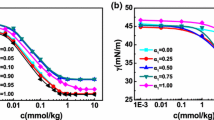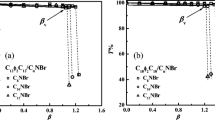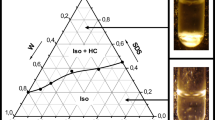Abstract
The interaction and complex formation between cationic surfactants dimethyldioctadecylammonium Bromide (DODA-Br) and a polyoxomolybdate (POM)-based giant cluster {Mo72Fe30}, in its both single cluster (in aqueous solution, these clusters exist as anions) format and supramolecular format in aqueous solution, are studies by using laser light scattering (LLS) techniques. DODA/{Mo72Fe30} complexes containing basically single {Mo72Fe30} clusters are observed when the {Mo72Fe30} aqueous solution is freshly prepared and contains mainly unimer or oligmer {Mo72Fe30} anions. The {Mo72Fe30} clusters tend to form supramolecular vesicle structures slowly in solution. At high surfactant concentrations, the DODA cationic surfactants can break the vesicle structure and form single {Mo72Fe30}/DODA complexes. At low surfactant concentrations, complexes containing the whole vesicles coated by a layer of DODA is formed and transferred into the organic phase. For the surfactant concentrations in between, the vesicles are partially destroyed, leading to the formation of complexes with large size distribution. Studying the behaviors of the interaction between DODA and {Mo72Fe30} anionic structures will help to further explore the complicated mechanism of the POM vesicle formation, which was recently discovered but still not fully understood. Such unique complex structures may also have potential applications as nanoreactors or nanocontainers.
Similar content being viewed by others
References
F. Secheresse, H. Ratajczak, and A. Müller (2002).J. Clust. Sci. 13, 265.
A. Müller, P. Kögerler, and A. W. M. Dress (2001). Coordin. Chem. Rev. 222, 193and the references therein.
A. Müller, E. Krickemeyer, H. Bögge, M. Schmidtmann, C. Beugholt, S. K. Das, and F. Peters (1999). Chem. Eur. J. 5, 1496and the references therein.
A. Müller, S. K. Das, V. P. Fedin, E. Krickemeyer, C. Beugholt, and H. Bögge (1999). Z. Anorg. Allg. Chem. 625, 1187.
A. Müller, M. Koop, H. Bögge, M. Schmidtmann, and C. Beugholt (1998). Chem. Commun. 15, 1501.
A. Müller, E. Krickemeyer, H. Bögge, M. Schmidtmann, and F. Peters (1998). Angew. Chem. Int. Ed. 37, 3360.
A. Müller, S. Sarkar, S. Q. N. Shah, H. Bögge, M. Schmidtmann, S. Saarkar, P. Kögerler, B. Hauptfleisch, A. X. Trautwein, and V. Schünemann (1999). Angew. Chem., Int. Ed. Engl. 38, 3238.
A. Müller, M. Luban, C. Schroder, R. Modler, P. Kögerler, M. Axenovich, J. Schnack, P. Canfield, S. Bud'ko, and N. Harrison (2001). Chemphyschem. 2 (8–9), 517.
A. Müller, E. Diemann, C. Kuhlmann, W. Eimer, C. Serain, T. Tak, A. Knöchel, and P. K. Pranzas (2001). Chem. Commun. 19, 1928.
T. Liu (2002). J. Am. Chem. Soc. 124, 10942.
T. Liu (2003). J. Am. Chem. Soc. 125, 312.
T. Liu, E. Diemann, H. Li, A. W. M. Dress, and A. Müller (2003). Nature 425, in press.
D. Volkmer, A. D. Chesne, D. G. Kurth, H. Schnablegger, P. Lehmann, M. J. Koop, and A. Müller (2000). J. Am. Chem. Soc. 122, 1995.
D. G. Kurth, P. Lehmann, D. Volkmer, H. Cölfen, M. J. Koop, A. Müller, and A. D. Chesne (2000). Chem. Eur. J. 6, 385.
D. Volkmer, B. Bredenkötter, J. Tellenbröker, P. Kögeler, D. G. Kurth, P. Lehmann, H. Schnablegger, D. Schwahn, M. Piepenbrink, and B. Krebs (2002). J. Am. Chem. Soc. 124, 10489.
D. G. Kurth, P. Lehmann, D. Volkmer, A. Müller, and D. Schwahn (2000). J. Chem. Soc., Dalton Trans. 21, 3989.
There are two different types of {Mo72Fe30} in crystal structures [18]. The one with R¯3 structure has neutral, discrete units was used for this study. Another type of crystal has the space group Cmca. This type of clusters tends to cross-link together via a solid-state reaction by forming Fe-O-Fe bonds. The as-formed oligmers can even be observed in gas phase [19].
A. Müller, S. K. Das, E. Krickemeyer, P. Kögerler, H. Bögge, and M. Schmidtmann (2000). Solid State Sci. 2 (8), 847.
A. Müller, E. Diemann, S. Q. N. Shah, C. Kuhlmann, and M. C. Letzel (2002). Chem. Comm. 5, 440.
(a) S. W. Provencher (1979). Makromol. Chem. 180, 210
(b) S. W. Provencher (1982). Comput. Phys. Commun. 27, 213, 229.
Author information
Authors and Affiliations
Rights and permissions
About this article
Cite this article
Liu, T. Surfactant-Induced Trans-Interface Transportation and Complex Formation of Giant Polyoxomolybdate-Based Clusters. Journal of Cluster Science 14, 215–226 (2003). https://doi.org/10.1023/B:JOCL.0000005059.45273.f8
Issue Date:
DOI: https://doi.org/10.1023/B:JOCL.0000005059.45273.f8




